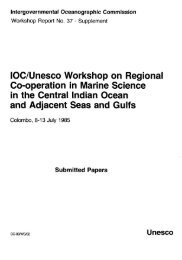Manual on sea level measurement and ... - unesdoc - Unesco
Manual on sea level measurement and ... - unesdoc - Unesco
Manual on sea level measurement and ... - unesdoc - Unesco
- No tags were found...
You also want an ePaper? Increase the reach of your titles
YUMPU automatically turns print PDFs into web optimized ePapers that Google loves.
Sea Level Measurement <strong>and</strong> Interpretati<strong>on</strong>under test. The manufacturer could not solve the problem<strong>and</strong> a method of post-data-processing was devisedto improve the absolute accuracy of the data back tothe claimed 0.05%. This post-data-processing couldhowever <strong>on</strong>ly be carried out <strong>on</strong>ce all gauges in thenetwork had been calibrated in situ to establish theirindividual calibrati<strong>on</strong> factors.A refined method for in situ calibrati<strong>on</strong> was devised asa quality c<strong>on</strong>trol tool. The method allows the followingto be reliably established <strong>on</strong> site:• Absolute accuracy• Measurement repeatability• Instrument datum offset.All gauges in the SAN tide gauge network are nowcalibrated every six m<strong>on</strong>ths, using carb<strong>on</strong> graphitepoles of known length <strong>and</strong> a stainless steel target thatis suspended below the gauge.Data received from the gauge are very ‘spiked’. Thestability of the readings is also erratic. This spiking inthe data creates a problem when the time arrives forthe annual tidal predicti<strong>on</strong> run. The spikes have to beedited out of the data by h<strong>and</strong> – each day’s data haveto be manually plotted, checked against the graphicsproduced by the Tech Tidal Assistant <strong>and</strong> then editedinto the analysis programme, before predicti<strong>on</strong>s can becalculated. This is a very unscientific, time-c<strong>on</strong>sumingprocess <strong>and</strong> human error comes into play.The quality of the lightning protecti<strong>on</strong> within the unitis not up to st<strong>and</strong>ard. A perfect example of this is thegauge in East L<strong>on</strong>d<strong>on</strong>. It was struck by lightning <strong>and</strong>this caused a fire in the gauge. Since the HydrographicOffice had placed the instrument box inside a watertightmetal box, the fire burnt itself out, owing to lackof oxygen. It would appear that the data logger wasnot damaged in the lightning strike/fire. The powersupply, juncti<strong>on</strong>-box teleph<strong>on</strong>e line <strong>and</strong> modem weredamaged.What the tidal department calls a ‘kick-start’ is thesoluti<strong>on</strong> to the problem of periodic unwillingness todownload data. Periodically, the power supply has tobe disc<strong>on</strong>nected from the gauge, followed by a waitof 30 sec<strong>on</strong>ds <strong>and</strong> then restorati<strong>on</strong> of the power supply.This problem is becoming more <strong>and</strong> more frequent<strong>and</strong> the down-time that it is creating in data analysis isbecoming problematical.In the last five years it has become evident that thetransducers are beginning to rust <strong>and</strong> this is gettingprogressively worse. The HO is unsure whether the rustis affecting the quality of the data; however, this is apossibility, as the transducers that have little or no rustare not creating as many problems.Kalesto radar gaugeThe OTT Kalesto radar gauge was tested by the TidalDepartment <strong>and</strong> under calibrati<strong>on</strong> from 12 to 15 April2002. After analysis of 1,443 readings (with a mean of2.4955 m, say 2.496 m) it was found that, in general:• 81% of the readings were within 2 mm of theabove-stated mean• 93% of the readings were within 3 mm of thismean• 97% of the readings were within 5 mm of thismean.An independent study to check-calibrate the Kalestoradar tide gauge was carried out by IMT <strong>on</strong> request bythe SAN Tidal Superintendent. The study showed that,during the calibrati<strong>on</strong> period, the Kalesto performedc<strong>on</strong>sistently within the manufacturer’s claimed accuracyparameters over the 2–7 m range. The absoluteaccuracy of the gauge under test had a st<strong>and</strong>ard deviati<strong>on</strong>of better than 3 mm over the 2–7 m range. Theindependent study c<strong>on</strong>firmed the results achieved bythe SAN Hydrographic Office.The refined method for in situ calibrati<strong>on</strong> devised forthe SRD tide gauge as a quality c<strong>on</strong>trol tool is used tocalibrate the Kalesto gauge every six m<strong>on</strong>ths.The data received from the gauge have very little ‘spiking’in the graphics; this is due to the 17 s measuringinterval. The low spike density is evident in the graphics<strong>and</strong> in the l<strong>on</strong>g run there will be very little editing ofthe data before the predicti<strong>on</strong>s can be produced, thusimproving <strong>on</strong> the accuracy of the Hydrographic Office’spredicti<strong>on</strong>s. The quality of data being sent to theGLOSS Fast Centre has also increased, not <strong>on</strong>ly in qualitybut also in frequency of data transfer. (Fast Data)This gauge is factory-fitted with an integrated lightningprotector to reduce the possibility of damage caused byexcess voltage (e.g. lightning or power surges.)Future prospectsThe SAN Hydrographic Office intends to upgradeits entire tide gauge network with the Kalesto radartide gauges. It is proposed to install a GPS receiverat Durban. It is also proposed to install a tide gauge<strong>and</strong> GPS receiver <strong>on</strong> Mari<strong>on</strong> Isl<strong>and</strong>, in c<strong>on</strong>necti<strong>on</strong> withHARTRAO, thus restoring the South African GLOSS stati<strong>on</strong>status to its original 100% capability.Currently, ‘fast data’ are being sent to the GLOSS FastCentre, at the University of Hawaii, from the Sim<strong>on</strong>’sTown, Richards Bay, Port Nolloth, Port Elizabeth <strong>and</strong>East L<strong>on</strong>d<strong>on</strong> gauges. The remaining RSA stati<strong>on</strong>s willbe included in the fast-data streams <strong>on</strong>ce they havebeen upgraded to the Kalesto radar gauge.68IOC <str<strong>on</strong>g>Manual</str<strong>on</strong>g>s <strong>and</strong> Guides No 14 vol IV
















